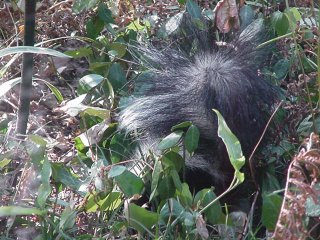 |
Creature
Feature - Angie Brown
August: Skunks
 If
you find that you have a skunk living in a place he shouldn't be, check
with the S.K.U.N.K.S. site listed above for help on making the skunk's
hiding place less desireable: trap and kill is NOT your only option, nor
is it recommended at all unless it has bitten someone! My favorite tip
(and one that can be used with any unwanted critter) is to sprinkle
flour near the opening -- they'll leave footprints so you can tell if
they're in or out before blocking up the hole.
If
you find that you have a skunk living in a place he shouldn't be, check
with the S.K.U.N.K.S. site listed above for help on making the skunk's
hiding place less desireable: trap and kill is NOT your only option, nor
is it recommended at all unless it has bitten someone! My favorite tip
(and one that can be used with any unwanted critter) is to sprinkle
flour near the opening -- they'll leave footprints so you can tell if
they're in or out before blocking up the hole.
For the last five years, my husband and I have maintained our yard naturally. We've provided plants with edible fruits and seeds, water, and a brush pile for shelter. Those of us who have created backyard wildlife habitats really have no right to expect that we'll get to pick and choose the creatures that enjoy it.
So what am I going to do about my skunks? Watch, learn, take pictures, try not to startle one, appreciate that they eat mice and rats, and wait for these beautiful creatures to move on.
August: Skunks
| Just when I thought I'd photographed about everything I can in
the back yard (except for the camera-shy raccoons), I have new tenants
under the back deck. For now I've named them Pepe and Peter. They're
just babies right now, and we've been seeing them during the day
as early as 9 a.m. and as late as 7 p.m. Needless to say, we keep
our eyes wide open when we're outside now. Although Doug (my husband) and I were somewhat upset when we first noticed the skunks (he walked between them on the sidewalk to the front door, and I just about ran into one on the doorstep after getting the mail), we've done some homework and have learned a lot: |
  Sources for this article include the following sites, which are also recommended for further reading: S.K.U.N.K.S. Scentral (Society of Kind Understanding for Not Killing Skunks) A very informative site! Includes myths about skunks, how to discourage them from being near your home, what to do if you or your pet gets sprayed, and much more. Skunk & Oppossum Website The title about sums it up. Another good reference! Skunk Spray Movie This is located on the above website. Don't watch if you're easily grossed out! It's a .mov file: you must have Windows Media Player or Quicktime to view it. Skunks as Pets Includes a FAQ on skunks as pets. |
 If
you find that you have a skunk living in a place he shouldn't be, check
with the S.K.U.N.K.S. site listed above for help on making the skunk's
hiding place less desireable: trap and kill is NOT your only option, nor
is it recommended at all unless it has bitten someone! My favorite tip
(and one that can be used with any unwanted critter) is to sprinkle
flour near the opening -- they'll leave footprints so you can tell if
they're in or out before blocking up the hole.
If
you find that you have a skunk living in a place he shouldn't be, check
with the S.K.U.N.K.S. site listed above for help on making the skunk's
hiding place less desireable: trap and kill is NOT your only option, nor
is it recommended at all unless it has bitten someone! My favorite tip
(and one that can be used with any unwanted critter) is to sprinkle
flour near the opening -- they'll leave footprints so you can tell if
they're in or out before blocking up the hole.For the last five years, my husband and I have maintained our yard naturally. We've provided plants with edible fruits and seeds, water, and a brush pile for shelter. Those of us who have created backyard wildlife habitats really have no right to expect that we'll get to pick and choose the creatures that enjoy it.
So what am I going to do about my skunks? Watch, learn, take pictures, try not to startle one, appreciate that they eat mice and rats, and wait for these beautiful creatures to move on.